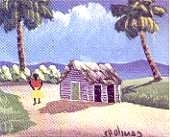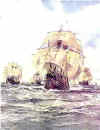|
|
|
DOMINICAN OVERVIEW &
HISTORICAL SUMMARY
(Politics) (Economy) (Taínos) (Europeans & Africans) (Colonial Era)
Populati on
statistics--The Dominican Republic today has a
population of approximately 9 million people, the majority of whom are criollos,
a biological mixture of Indians, Europeans and Africans; the official census
lists the population as being 73% mixed, 16% white, and 11% black. It is an
urban nation (61% of the Dominican population lives in an urban environment)
with an 80% literacy rate. Approximately 2 million Dominicans live in the
capital city of Santo Domingo de Guzmán. The second-largest city is Santiago de
los Caballeros, with a population of 700,000, followed by San Cristóbal with
410,000, La Vega with 335,000, Puerto Plata with 255,000, Duarte with 272,000,
and San Pedro de Macoris with 213,000.
on
statistics--The Dominican Republic today has a
population of approximately 9 million people, the majority of whom are criollos,
a biological mixture of Indians, Europeans and Africans; the official census
lists the population as being 73% mixed, 16% white, and 11% black. It is an
urban nation (61% of the Dominican population lives in an urban environment)
with an 80% literacy rate. Approximately 2 million Dominicans live in the
capital city of Santo Domingo de Guzmán. The second-largest city is Santiago de
los Caballeros, with a population of 700,000, followed by San Cristóbal with
410,000, La Vega with 335,000, Puerto Plata with 255,000, Duarte with 272,000,
and San Pedro de Macoris with 213,000.
Religion--The vast majority of Dominicans
are Roman Catholic (95%), but some regions of the country have historically
significant Protestant populations (Samaná and San Pedro de Macorís, for
example), and
Sosua has an historically significant population of Jews.
In recent decades, evangelical sects like the Seventh Day Adventists and
Jehovah's
Witnesses have been gaining converts all over the country, as have the Mormons,
who have recently finished the construction of a huge temple in the Capital.
Listen! What's that drumming and tinkling?
It's a group of robed and barefoot Hari Krishnas dancing their way down
the Conde.... There is complete freedom of religion here in the Dominican
Republic.
Politics--Politics is the favorite topic at most cafés and street corners, next to discussing women, that is, and fills the daily news. A democracy, the Dominican government is divided into three branches, like that of the U.S.A.: Executive, Legislative and Judicial. The president selects the provincial governors, who are his representatives there, but the balance of the provincial and municipal councils are filled with locally elected officials. Up
Presidential elections take place every four years. The current president is Hipólito Mejía, of the “white” party, the peoples’ party, who replaced Dr. Leonel Fernández in August of 2000—it is against the Dominican constitution for anyone to be in the presidential office two terms in a row, but the current administration is trying to change that part of the Constitution before the elections of 2004.
I overheard a tour guide joke that there are as many political parties as there are Dominicans. That sometimes doesn't seem too far from the truth. The most powerful since the 1960s, however, has been the PRSC (Partido Reformista Social Cristiano or "Social Christian Reform Party"), which was formed by Dr. Joaquín Balaguer's. Balaguer was the number one political figure in the country for more than 40 years. He was president seven times and, at other times, was the "puppeteer" behind other presidents. He was one of the leading candidates in the presidential election of 2000 and told the press over and over that he planned to run again in 2004—but he died in 2002. Politics is a persistent force in Dominican life, and, as you can see by Balaguer’s example, Dominican politicians are persistent.
Economy—The
Dominican Republic is a poor country, with a Gross National Product per capita
income of approximately US$1,600. This
amount, however, is lopsidedly distributed among a very small elite composed of
business owners, professionals and foreign nationals, while the vast majority of
Dominicans remain well below recognized poverty levels.
There is a very small middle class, but, as in other Latin American and
Caribbean countries, it is slowly growing bigger and stronger.
(See “Jobs” in the CULTURE section.) Up
The economic emphasis of the Dominican Republic has changed several times in the past 500 years. An early emphasis on gold mining quickly changed to sugar cane by the 1520s, then to cattle raising and tobacco, where it remained for several centuries, though sugar made a brief comeback just before the Haitian Revolution. Inordinately high sugar prices at the turn of the 20th century re-set the clock, bringing back the sugarcane ingenios. Today, however, the number one industry is tourism, followed by communications, agriculture (principal exports include coffee, cocoa beans, sugar cane, pineapples, oranges, bananas and plantains, and a variety of vegetables; also tobacco and flowers) and income from the Zonas Francas, the Free Trade Zones. Actually, income sent home from abroad by Dominican extra-nationals exceeds per capita income from everything except tourism—and most of the tourism profits go to foreigners or to foreign-based corporations, as do most profits from the Zonas Francas. Mining products are also exported, including gold, ferronickel, rock salt, gypsum, and marble.The island’s first peopling—The first people to inhabit what would one day be the Dominican Republic were small groups of fishermen, hunters and gatherers, a simple Stone-Age people, who arrived via canoe sometime between 5,000 BC and 4,000 BC, fully 5,500 to 6,500 years before the arrival of Europeans. These earliest “Indians,” as Columbus would later call them, are known to archaeologists and historians as the Guanahatabey (or Ciboney) people. They most likely migrated here from the Yucatán Peninsula via Caribbean islands that are now submerged but that used to lie between the eastern tip of Central America and Jamaica. Several other waves of Indian peoples (archaeological evidence indicates that there were at least four more) migrated up the Antillian chain over the next four millennium, mostly emanating from the Orinoco River Valley region of northern South America—we call them Pre-Igneris and Igneris.Up
Development of the Taínos--The Indians who arrived approximately the same time that Christ was walking about in Jerusalem brought with them a knowledge of ceramics, semi-sedentary agriculture based on maize and yucca, a religion based on zemí worship (ancestor spirit-guides and mythical gods represented on earth by artistic symbols and objects of the same name), and ceremonies that included community-wide dancing/singing festivals called areitos and soccer-like ball games called bateyes. They conquered and/or merged with the existing Guanahatabey people, evolving into a people, language, and culture unique to the region, a people, language, and culture that today we call Taíno (archaeologists used to call these people Island Arawaks, a term that is still in limited use). When Christopher Columbus anchored in 1492 along the shores of the island that the Taínos called Quisqueya—Columbus dubbed it Hispaniola--he found a highly developed people living in an interconnected polity of cacicazgos, with at least five supreme caciques (chiefs). Behecchio, the most powerful of those five supreme caciques, appears to have been in the process of consolidating the cacicazgos into one unified state. It is speculated, had the Taínos’ development not been interrupted so abruptly at the close of the 15th century, that within another 100 years they would have developed a political state, society, and culture as advanced as those of the mainland’s Aztec and Inca peoples. Up
Just
how many Taínos there were on Hispaniola in 1492 we will probably never know.
Demographers are still arguing numbers that vary from as few as 200,000
to as many as 2 million. Archaeological
studies indicate that the higher numbers appear more likely, for the Taínos had
an abundance of protein (mainly fish and other marine creatures, plus
fresh-water and salt-water birds), carbohydrates (corn and yucca, plus a
multitude of other root vegetables), and a vitamin-rich variety of fruits and
vegetables.
Arrival
of Europeans and Africans, and birth of the first criollos—On
December 5, 1492, two of Columbus’s ships anchored off Quisqueya’s north
shore, where the men debarked, gave thanks to God, and dubbed the island
Hispaniola, claiming it for the Spanish monarchs Ferdinand and Isabella.
They spent the next three weeks cruising along the coast, trading with
various groups of Taínos and making brief inland excursions.
It is probably safe to say that the first criollos
(or mestizos), the offspring of Spanish fathers and Taíno mothers, were
born on Hispaniola nine months later.
Columbus’s flagship, the Santa María, hit a reef and sank on Christmas Eve. No one died, but the ship was not salvable, and all the Europeans could not return in the tiny Niña (Martín Alonso Pinzón, captain of the third ship, the Pinta, had headed off to look for gold; he and Columbus would not meet up again until they were both back in Spain). Taínos helped the Spaniards canoe the remains of the Santa María ashore, where they used the wood and nails to build Fort La Navidad. Columbus left 39 men at the fort to gather gold in anticipation of his return. Up
When
Columbus returned to Hispaniola late the following year, all of the Europeans
he’d left behind were dead, victims of greed and cultural clash.
It seems that they mistook the Taíno custom of offering unmarried women
to elite visitors for a total lack of sexual restrictions on the Taínos’
part—a big mistake. No doubt the
Europeans broke other Taíno taboos as well over the months that they awaited
the Admiral’s return. One of the
five supreme caciques, Caonabó, led a raid to kill the savage newcomers who did
not know how to live among civilized Taínos.
Columbus
1493 fleet comprised 17 ships and more than 2,500 men, among whom were a number
of “ladinoized” men of African descent, meaning that they were freedmen who
had been baptized Catholic, spoke the Spaniards’ language, and were accustomed
to Spanish culture. They are not
distinguishable in the documents from other Spaniards of the era, for the racial
categories that are such an everyday part of our lives today did not exist in
the 15th or early 16th centuries.
What was important was whether you were free or enslaved, married or
unmarried, of aristocratic status or not. In
fact, despite the multi-ethnic biological mixture that obviously took place on
Hispaniola over the next several decades as more Europeans (mostly men) arrived,
and as both African slaves and Indians from other regions were imported to
supplement Taíno workers, there was no census category for either mestizos or
mulattos until 1584! Up
Tragically, somewhere between 80-90% of the perhaps 2 million Taínos who inhabited Quisqueya when the Spaniards arrived were dead within a few generations of “The Encounter.” They died in battles, they died from abuse and exploitation in the gold mines and other labors to which the Europeans subjected them, but mostly they died as a result of non-immunity to viruses and bacteria that were inadvertently carried to the island along with the Europeans, Africans, and their domestic animals. Chroniclers such as Bartolomé de las Casas wrote that the Taínos all died, but they purposely exaggerated the demographic catastrophe. The fact is that between 10-20% survived to mingle their genes and their cultural traditions with those of the new Indian, European, and African arrivals..